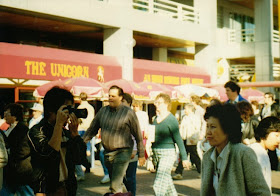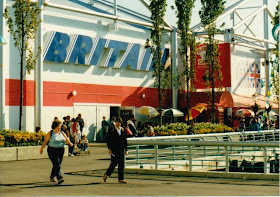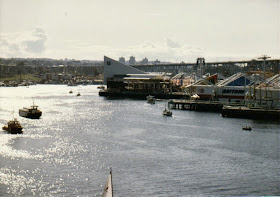In some ways the province of British Columbia has long
been Canada’s California. You might also say that Vancouver is Canada’s Los
Angeles. If you grew up in a major Canadian city in the east like Toronto or
Montreal, or in a small town like
Cochrane in Northern Ontario or Truro, Nova Scotia, you probably hoped to go
out west at some point in your life and see for yourself what it would be like
to take in the tall trees and deep forests, the big mountains, and the Pacific
Ocean. If you were a hippie back in the day maybe you planned on spending a
summer naked out on Long Beach on the west side of Vancouver Island.
Many Canadians who have visited Vancouver over the years
have decided to make it their home. Some chose to live there because of the
climate and lack of snow and bitter cold in the winters. For others it was the
spectacular beauty of the city, the mountain backdrop on the north shore, the
sandy beaches, Stanley Park.
Probably the first major transformation of Vancouver from
a medium sized city with an economy that was based largely on the forestry
industry to more cosmopolitan city, was the building of high rise apartment
buildings in the downtown west side that started in the 1960s. Restaurants with
foreign cuisines started appearing.
Up until the late 1970s there were still restaurants
around that didn’t have liquor licences and the police looked the other way if
you brought your own booze with you and had it served to you by your waiter.
Back then Woodward’s was a locally owned department store chain, you went to
the Army & Navy Store for fishing tackle and camping gear, Mitzi Gaynor was
still turning up once a year to appear at The Cave Supper Club. Beer joints
like The Ritz Hotel on West Georgia Street were where the younger crowd hung
out. The wealthy were sipping their cocktails with paper umbrellas at Trader Vic’s
next to The Bayshore Hotel and dining at The Devonshire Hotel.
1986 was Vancouver’s centennial year. Various ideas were
kicked around as to how to celebrate the occasion. The initial proposal for a
“fair” was introduced in the late 1970s. The theme from the start was
“transportation” and the importance of Vancouver as both a port city and a
railway hub that connected to the rest of Canada.
Contrary to what many believe, Expo 86 was never a “class
A” world’s fair like the ones in Montreal, Brussels, and New York City. Expo 86
was more of a “class B” fair. Whatever it was, it was a big deal for the city
of Vancouver and for Canada. The transportation premise morphed into including
communications. Originally the fair was going to cost about 80 million dollars
but that figure later grew to over 800 million dollars.
The place that was chosen as the location for the fair
was an area east of downtown Vancouver called False Creek. False Creek is a salt
water inlet. For many years the land in this area was used for industrial
purposes. At one time the Canadian Pacific had their railway yards there. By
the late 70s most of the industries had moved away from the area as it was too
congested for transportation of finished products.
A good part of the land on the northern side of False
Creek was mud flats. In the late 70s there was still a cooperage that made
barrels and an upscale seafood restaurant called Ondine’s in the area. One of
the difficulties in reclaiming the mud flats was soil contamination from over a
century of being used for industrial purposes.
The closest bridge to the Expo 86 site was a wooden swing
bridge structure called the Cambie Street Bridge. It was torn down and replaced
by a new bridge in 1985. For many years Vancouver football fans watched their
BC Lions play at Empire Stadium on the east side of Vancouver near the suburb of Burnaby. It was at Empire
Stadium in 1954 that the first sub 4 minute mile was run. Roger Bannister snuck
by John Landy while Landy was looking over his shoulder. Empire Stadium just
wasn’t going to cut it as a good representation of Vancouver during Expo 86 and
it was also out of the way.
 |
| BC Place Stadium on the left. |
The construction of BC Place was completed in 1983. It
has a seating capacity of about 60,000 people. Over the years I have seen some
diverse forms of entertainment there. May years ago I saw Bob Hope do his
comedy act there at an exhibition baseball game with the Seattle Mariners as
one of the participants. I think one of the ball players broke a leg rounding 2nd
base and that’s why we don’t see any more baseball exhibition games at BC
Place. I may be wrong. I watched a
soccer game between the Vancouver Whitecaps and the New York Cosmos when every
one of the 60,000 seats had a bum in it. I also saw Bjorn Borg and John
MacEnroe play tennis at BC Place when they were past their prime. I went to a “Saskatchewan
Day” thing at BC Place during Expo 86. My ex was from Saskatchewan. I remember
a security guard sharing a joint in the washroom with some of his Saskatchewan
pals.
The initial SkyTrain line (light rapid transit) was
completed in 1985 in time for the fair. It wouldn’t look good having a fair
with a transportation theme without some more modern way of moving people
about.
 |
| Monorail not Skytrain |
I was living in Montreal in the 1960s and worked on
construction on Expo 67. I was familiar with major construction transforming a
city. I also knew about the pride and spirit that comes along with a fair when
local residents show off their city to millions of tourists. It was going to be
a fun time to be living in Vancouver for many.
I can’t say that I was a frequent visitor to Expo 86. I
had just started a new business in May of 1986 and was putting all my profits
back into the company. In hindsight, I probably should have used my credit card
and gone to the fair more often. What difference would 500 bucks spent on the
plastic have made? All in all I think we went to the fair about 6 times.
 |
| My Expo 86 season pass. |
 |
| Monk McQueen's |
 |
| The Unicorn. |
 |
| Beer Garden. |
When the fair ended, Expo 86 had attracted over 22
million visitors. The deficit was 311 million dollars. 311 million dollars
certainly sounds like a lot but it is offset by the legacy of the fair. The
sphere like Science World still sits at the end of False Creek. SkyTrain has
expanded its routes a number of times over the years. Canada Place is now where
cruise ships to Alaska berth while in the port of Vancouver. The biggest hockey
stick in the world was shipped over to the small city of Duncan on Vancouver
Island. The world’s largest flag pole is now located by a car dealership in
Surrey, BC.
 |
| Science World. |
 |
| Canada Place |
 |
| BC premier Bill Vander Zalm. |
When the whole deal was over a good part of the land
where Expo 86 was situated was sold off to Hong Kong business magnate Li
Kai-Shing for a fraction of what it was worth. The floating MacDonald’s
restaurant, nick named “McBarge”, was abandoned in the Burrard Inlet years ago
and can still be seen today.
Expo 86 was a turning point in the history of Vancouver.
There is no doubt that today it is a world class city.
 |
| McBarge. |
The following is a list of some of the entertainers who
turned up for Expo 86 starting with the ones no longer with us.
Bob Hope, Liberace, Roy Orbison, Miles Davis, Lou Rawls,
Johnny Cash, John Denver, Peter Allen, Red Skelton, and Jacques Cousteau. Other
notables were Loverboy, Manhattan Transfer, Harry Belafonte, Anne Murray, The
Eurythmics, Julio Eglesias, Joan Baez,
Kenny Loggins, Smokey Robinson, The Beachboys, Don McLean, The Temptations, k.d.
Lang, Bryan Adams, and Jerry lee Lewis.






















You've brought back lots of great memories Colin but I have two minor corrections.
ReplyDeleteEmpire Stadium was not in Burnaby. It was at the east end of the Pacific National Exhibition (PNE) grounds, which is still well inside Vancouver. Burnaby city limits start at Boundary Road, which is three blocks east of the PNE.
The caption identifying SkyTrain is wrong. The photo shows the temporary monorail installed by a Swiss company for the duration of the fair. When Expo 86 was over, the monorail was dismantled and reassembled in England.
Yep. You are right. I'll correct those errors. Isn't Boundary Road where Burnaby begins? I wondered a bit for a moment when I captioned the monorail. Thanks.
ReplyDeleteYes, Boundary Road is Burnaby's western border and Vancouver's eastern border. Great photos and memories! Hard to believe it was 28 years ago Even harder to believe Montreal's Expo 67 was 47 years ago! Where do those years go?
ReplyDeleteThe wooden bridge was called The Connought Bridge. It was nicknamed The Cambie Street Bridge. The replacement bridge was named The Cambie Street Bridge.
ReplyDeleteThis comment has been removed by a blog administrator.
ReplyDelete